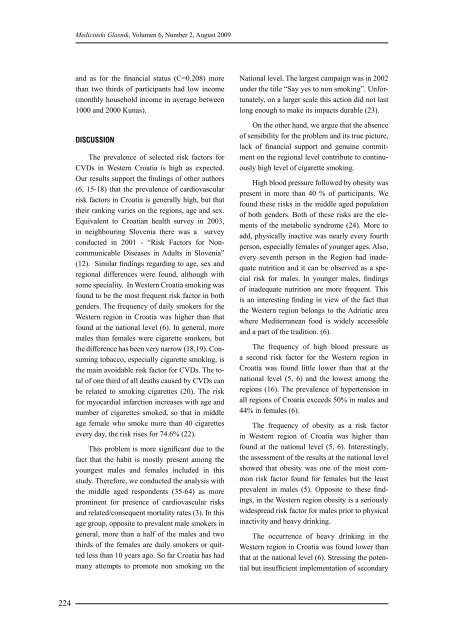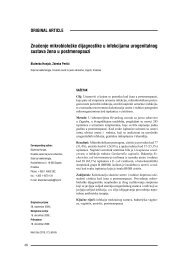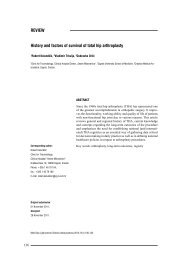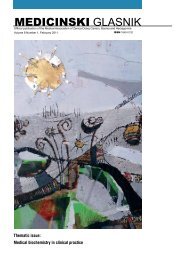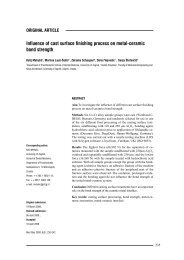MEDICINSKI GLASNIK
MEDICINSKI GLASNIK
MEDICINSKI GLASNIK
Create successful ePaper yourself
Turn your PDF publications into a flip-book with our unique Google optimized e-Paper software.
224<br />
Medicinski Glasnik, Volumen 6, Number 2, August 2009<br />
and as for the financial status (C=0.208) more<br />
than two thirds of participants had low income<br />
(monthly household income in average between<br />
1000 and 2000 Kunas).<br />
DISCUSSION<br />
The prevalence of selected risk factors for<br />
CVDs in Western Croatia is high as expected.<br />
Our results support the findings of other authors<br />
(6, 15-18) that the prevalence of cardiovascular<br />
risk factors in Croatia is generally high, but that<br />
their ranking varies on the regions, age and sex.<br />
Equivalent to Croatian health survey in 2003,<br />
in neighbouring Slovenia there was a survey<br />
conducted in 2001 - “Risk Factors for Noncommunicable<br />
Diseases in Adults in Slovenia”<br />
(12). Similar findings regarding to age, sex and<br />
regional differences were found, although with<br />
some speciality. In Western Croatia smoking was<br />
found to be the most frequent risk factor in both<br />
genders. The frequency of daily smokers for the<br />
Western region in Croatia was higher than that<br />
found at the national level (6). In general, more<br />
males than females were cigarette smokers, but<br />
the difference has been very narrow (18,19). Consuming<br />
tobacco, especially cigarette smoking, is<br />
the main avoidable risk factor for CVDs. The total<br />
of one third of all deaths caused by CVDs can<br />
be related to smoking cigarettes (20). The risk<br />
for myocardial infarction increases with age and<br />
number of cigarettes smoked, so that in middle<br />
age female who smoke more than 40 cigarettes<br />
every day, the risk rises for 74.6% (22).<br />
This problem is more significant due to the<br />
fact that the habit is mostly present among the<br />
youngest males and females included in this<br />
study. Therefore, we conducted the analysis with<br />
the middle aged respondents (35-64) as more<br />
prominent for presence of cardiovascular risks<br />
and related/consequent mortality rates (3). In this<br />
age group, opposite to prevalent male smokers in<br />
general, more than a half of the males and two<br />
thirds of the females are daily smokers or quitted<br />
less than 10 years ago. So far Croatia has had<br />
many attempts to promote non smoking on the<br />
National level. The largest campaign was in 2002<br />
under the title “Say yes to non smoking”. Unfortunately,<br />
on a larger scale this action did not last<br />
long enough to make its impacts durable (23).<br />
On the other hand, we argue that the absence<br />
of sensibility for the problem and its true picture,<br />
lack of financial support and genuine commitment<br />
on the regional level contribute to continuously<br />
high level of cigarette smoking.<br />
High blood pressure followed by obesity was<br />
present in more than 40 % of participants. We<br />
found these risks in the middle aged population<br />
of both genders. Both of these risks are the elements<br />
of the metabolic syndrome (24). More to<br />
add, physically inactive was nearly every fourth<br />
person, especially females of younger ages. Also,<br />
every seventh person in the Region had inadequate<br />
nutrition and it can be observed as a special<br />
risk for males. In younger males, findings<br />
of inadequate nutrition are more frequent. This<br />
is an interesting finding in view of the fact that<br />
the Western region belongs to the Adriatic area<br />
where Mediterranean food is widely accessible<br />
and a part of the tradition. (6).<br />
The frequency of high blood pressure as<br />
a second risk factor for the Western region in<br />
Croatia was found little lower than that at the<br />
national level (5, 6) and the lowest among the<br />
regions (16). The prevalence of hypertension in<br />
all regions of Croatia exceeds 50% in males and<br />
44% in females (6).<br />
The frequency of obesity as a risk factor<br />
in Western region of Croatia was higher than<br />
found at the national level (5, 6). Interestingly,<br />
the assessment of the results at the national level<br />
showed that obesity was one of the most common<br />
risk factor found for females but the least<br />
prevalent in males (5). Opposite to these findings,<br />
in the Western region obesity is a seriously<br />
widespread risk factor for males prior to physical<br />
inactivity and heavy drinking.<br />
The occurrence of heavy drinking in the<br />
Western region in Croatia was found lower than<br />
that at the national level (6). Stressing the potential<br />
but insufficient implementation of secondary


